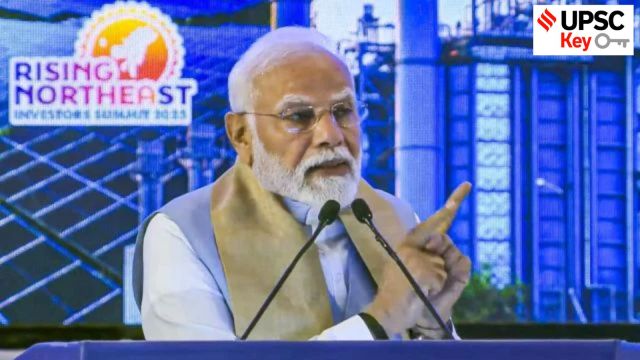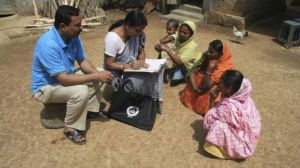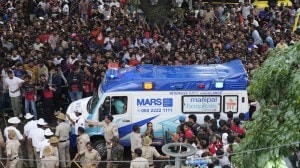UPSC Key: FATF, Rising Northeast summit, and Siang dam
Why is FATF’s June meeting relevant to the UPSC exam? What is the significance of topics such as the Tyre particles, Swachh Bharat scheme, and Make in India have on both the preliminary and main exams? You can learn more by reading the Indian Express UPSC Key for May 24, 2025.
 UPSC Key 24th May 2025: PM Modi addressing the 'Rising North East Investors Summit' said the Northeastern region is witnessing unprecedented progress (PTI)
UPSC Key 24th May 2025: PM Modi addressing the 'Rising North East Investors Summit' said the Northeastern region is witnessing unprecedented progress (PTI)Important topics and their relevance in UPSC CSE exam for May 24, 2025. If you missed the May 23, 2025, UPSC CSE exam key from the Indian Express, read it here.
FRONT
FATF’s June meet: India will hand dossier on Pak to get it back on grey list
Syllabus:
Preliminary Examination: Current events of national and international importance.
Main Examination: General Studies II: Important International institutions, agencies and fora- their structure, mandate.
What’s the ongoing story: India will take up terror funding charges against Pakistan to make a case for putting it back in the “grey list” of the Financial Action Task Force (FATF), the global money laundering and terror financing watchdog, government sources said.
Key Points to Ponder:
— What is the Financial Action Task Force (FATF)?
— How many lists are there under the FATF?
— What is the FATF GREY list?
— Why was Pakistan kept on the FATF Grey list?
— How does grey-listing under FATF impact a country?
— What are India’s arguments against providing funds to Pakistan?
— What is Recommendation 38 of FATF?
— What is money laundering?
— What is the Country Partnership Framework (CPF) of the World Bank?
Key Takeaways:
— India is, specifically, planning to flag Pakistan’s non-compliance of the legal provisions that it had committed itself to when it was taken off the grey list in 2022, sources said.
— When Pakistan was taken off the grey list in 2022, it was kept in the enhanced follow-up category by the FATF having been compliant with other recommendations but being ‘partially compliant’ with one recommendation (recommendation 38 of FATF) — a deficiency relating to the coverage of predicate offences.
— Originally, it was found to be non-compliant on recommendation 38 (R.38), the status for which was then changed to ‘partially compliant’ in the October 2022 review.
— In simpler terms, R.38 is regarding mutual legal assistance (MLA) for freezing and confiscation of proceeds of crime, mainly when crime has happened elsewhere and proceeds are in the relevant country (Pakistan in this case).
— Recommendation 38 of the FATF requires countries to have authority to take expeditious action in response to requests by other countries to identify, freeze and seize property laundered, proceeds from money laundering or predicate offences. Though Pakistan had issued guidelines for MLA, FATF had noted the deficiencies in its scheme for providing assistance to other countries.
— Separately, India will raise objections to a review of World Bank funding to Pakistan which is also slated for June, sources said. In January this year, World Bank and Pakistan launched a new Pakistan Country Partnership Framework (CPF) for FY2026-35.
— Being in this list adversely impacts FDI and capital flows as businesses have to undertake enhanced due diligence. Government officials had earlier said this had helped curtail illicit fund flows from Pakistan into India, especially into J&K.
— At present, FATF has put 25 countries including Kenya, Monaco, Nepal, South Africa, Vietnam in the grey list and three countries — North Korea, Iran and Myanmar — in the black list.
— Pakistan is not a member of FATF, but of Asia Pacific Group on Money Laundering (APG), the largest FATF-Style Regional Body. India is a member of APG as well as of the FATF.
— Pakistan spends, on an average, around 18 per cent of its general budget on “defense affairs and services”, while even conflict-affected countries spend on average far less (10-14 per cent of their general budget expenditure), as per public data, the source said.
— Further, Pakistan’s arms imports increased dramatically from 1980 to 2023 by over 20 per cent on average in the years when it received IMF disbursements in comparison to years when it did not, sources said
Do You Know:
— The Paris-based intergovernmental organisation FATF is the global money laundering and terrorist financing watchdog. It was formed in 1989 as a G7 initiative to examine and develop measures to combat money laundering. It originally included the G7 countries, the European Commission and eight other countries.
— According to the official site of FATF, “In April 1990, less than a year after its creation, the FATF issued a report containing a set of Forty Recommendations.” These recommendations aimed to provide a framework of measures to help countries tackle illicit financial flows.
— The 40 Recommendations are divided into seven distinct areas: (1) AML/CFT Policies and coordination, (2) Money laundering and confiscation, (3) Terrorist financing and financing of proliferation, (4) Preventive measures, (5) Transparency and beneficial ownership of legal persons and arrangements, (6) Powers and responsibilities of competent authorities and other institutional measures, (7) International cooperation.
— Later, in 2001, the FATF expanded its mandate to also combat terrorist financing. Since 2019, the FATF has had an open-ended mandate, after originally operating under fixed-terms.
— According to the official site of FATF, there are currently 40 members of the FATF; 38 jurisdictions and 2 regional organisations (the Gulf Cooperation Council (GCC) and the European Commission). There are also 31 international and regional organisations which are Associate Members or Observers of the FATF and participate in its work.
Other Important Articles Covering the same topic:
Prelims Question Covering similar theme:
(1) Consider the following statements with reference to the Financial Action Task Force (FATF)
1. It was formed in 1989 as a G7 initiative to examine and develop measures to combat money laundering.
2. India became a member of FATF in 1990.
3. Saudi Arabia and Pakistan are FATF member since June 2019.
How many of the statements given above is/are correct?
(a) Only one
(b) Two only
(c) All three
(d) None
UPSC Mains Question Covering similar theme:
Money laundering poses a serious threat to country’s economic sovereignty. What is its significance for India and what steps are required to be taken to control this menace? (2013)
GOVT & POLITICS
First ‘Made in India’ chip to soon come from semiconductor plant in Northeast: PM Modi
Syllabus:
Preliminary Examination: Current events of national and international importance
Mains Examination: General Studies-III: Achievements of Indians in science & technology; indigenization of technology and developing new technology.
What’s the ongoing story: Prime Minister Narendra Modi on Friday announced that the country will soon get the first ‘Made in India’ chip produced at the semiconductor plant in the Northeast region. He said the region is becoming an important destination for two sectors – energy and semiconductor.
Key Points to Ponder:
— What is the Made in India initiative of the Indian government?
— What is the objective and significance of this initiative?
— What are the factors influencing the location of the industries?
— What are the initiatives taken by the government to promote infrastructure projects in the Northeast?
— What is the significance of the Rising Northeast summit?
— What are the challenges in the development of infrastructure in the northeast regions?
— Know about the semiconductor mission of India
Key Takeaways:
— “Today, the Northeast is playing a larger role in strengthening the country’s semiconductor ecosystem. The country is soon going to get the first ‘Made in India’ chip from the semiconductor plant in the Northeast,” Modi said in his inaugural address at the Rising Northeast Investors Summit 2025.
— The prime minister said that the semiconductor plant has opened doors of opportunity for the semiconductor sector and other cutting edge- technology in the region.
— Modi said that the government is making large investments in areas of hydro or solar power in every state of Northeast, and projects worth crores have already been distributed.
— He said the Northeast, which was once called the frontier region, has now become a frontrunner for growth
— The prime minister said robust roads, good power infrastructure and a logistics network are the backbone of all the industries. Trade also flourishes where connectivity is seamless. This means robust infrastructure is the first condition for any development; it is the foundation.
— The government has invested heavily to improve connectivity infrastructure; in just one decade, 11,000 km of new highways have been constructed, along with several kilometers of rail lines have been laid in the Northeast, he said.
Do You Know:
— Make in India was launched by Prime Minister Narendra Modi on September 25, 2014. It aims to facilitate investment, foster innovation, enhance skill development, protect intellectual property & build best in class manufacturing infrastructure.
— Seen as an important ‘Vocal for Local’ initiative, its objective is twofold. Firstly, to boost India’s manufacturing capabilities and secondly to showcase its industrial potential on a global stage.
Key Initiatives to enable Make In India initiative
Production linked Incentive (PLI) Schemes:The primary goals of the PLI Schemes are to attract substantial investments, incorporate advanced technology, and ensure operational efficiency. These schemes cover 14 key sectors aimed at fostering investment in cutting-edge technology and promoting global competitiveness.
PM GatiShakti: It is a strategic initiative aimed at achieving Aatmanirbhar Bharat and a US $5 trillion economy by 2025 through the creation of multimodal and last-mile connectivity infrastructure. PM GatiShakti is a transformative approach for economic growth and sustainable development.
Semiconductor Ecosystem Development: It encompasses four key schemes:
- Modified Scheme for Setting Up Semiconductor Fabs in India
- Modified Scheme for Setting Up Display Fabs in India
- Modified Scheme for Setting Up Compound Semiconductors, Silicon Photonics, Sensors Fabs, and Discrete Semiconductors, along with Semiconductor Assembly, Testing, Marking, and Packaging (ATMP) / OSAT Facilities in India
- Design Linked Incentive (DLI) Scheme
— It aims to foster the development of a sustainable semiconductor and display ecosystem in the country.
— The Semicon India Programme aims to provide a significant impetus to semiconductor and display manufacturing by facilitating capital support and promoting technological collaborations.
Other Important Articles Covering the same topic:
📍Knowledge nugget of the day: 10 years of Make In India
UPSC Mains Question Covering similar theme:
“Success of ‘Make in India’ program depends on the success of the ‘Skill India’ programme and radical labour reforms.” Discuss with logical arguments. (2015)
With central forces and drilling equipment brought in, locals restart protest against Siang dam
Syllabus:
Preliminary Examination: Current events of national and international importance
Mains Examination: GS-II, GS-III: Government policies and interventions, Infrastructure, Environment, Growth & Development, Conservation.
What’s the ongoing story: Protests have again broken out in Arunachal Pradesh’s Siang district against the proposed 11,000 MW Upper Siang hydropower project. This comes days after security forces were moved into the area and the National Hydroelectric Power Corporation (NHPC) brought in equipment to begin drilling work for a project feasibility analysis.
Key Points to Ponder:
— Know about the Upper Siang hydropower project
— Read about the Siang river basin and other major rivers of Northeast India
— What are the issues and challenges associated with the various hydropower projects?
— How is a run-of-river hydroelectricity project different from any other hydroelectricity project?
— What measures should be taken to ensure developmental projects are sustainable and environmentally friendly?
Key Takeaways:
— The protesters, including those whose villages and farmlands would be affected by the dam, began an indefinite dharna at Beging in Siang district under the banner of Siang Indigenous Farmers’ Forum (SIFF).
— Beging is the site where state authorities and the NHPC have sought to begin core drilling work to prepare a pre-feasibility report (PFR) for the project, a step that has been stalled for a year because of local opposition.
— The Beging or Paring site is one of three proposed project sites along the Siang — the other two being Ugeng and Dite Dime.
— Last December, panic and protests had spread in the region after the state government took a decision to deploy nine companies of CAPF as well as additional police to the proposed project sites in a bid to begin the drilling work
— Both the central and state governments are pushing for the Siang dam as a means to counter the possible effects of the China’s planned 60,000 MW dam — the world’s largest hydro-electric project — on the Yarlung Tsangpo river in Tibet.
— The Yarlung Tsangpo flows into Arunachal Pradesh, where it is known as the Siang. It then joins other tributaries like the Dibang and Lohit to become the Brahmaputra in Assam.
Do You Know:
— The Upper Siang project is a proposed 11,000 megawatt hydropower project on the Siang river in the Upper Siang district of Arunachal Pradesh.
— The Siang originates near Mount Kailash in Tibet, where it goes by the name of Tsangpo. It traverses more than 1,000 km eastward, before forming a horseshoe bend around the towering Namcha Barwa peak, and enters Arunachal Pradesh as the Siang. Further downstream, in Assam, the river becomes the mighty Brahmaputra.
— In 2017, the government proposed to replace the planned 5,500 MW Siang Upper Stage-I and 3,750 MW Siang Upper Stage-II hydel projects with a single, multi-purpose project of higher capacity — the aforementioned Upper Siang project.
— Set to be built by the National Hydroelectric Power Corporation (NHPC), the project would entail the construction of a 300-metre high dam, the largest in the subcontinent, when completed.
Other Important Articles Covering the same topic:
📍Why locals are protesting against the Upper Siang hydropower project in Arunachal Pradesh
Previous year UPSC Prelims Question Covering similar theme:
(2) Consider the following rivers: (UPSC CSE 2014)
1. Barak
2. Lohit
3. Subansiri
Which of the above flows/flow through Arunachal Pradesh?
(a) 1 only
(b) 2 and 3 only
(c) 1 and 3 only
(d) 1, 2 and 3
Previous year UPSC Mains Question Covering similar theme:
Suppose the Government of India is thinking of constructing a dam in a mountain valley bound by forests and inhabited by ethnic communities. What rational policy should it resort to in dealing with unforeseen contingencies? (UPSC CSE 2018)
ECONOMY
Govt to seek Cabinet nod to tweak PM Internship Scheme Based on pilot rounds
Syllabus:
Preliminary Examination: Economic and Social Development
Main Examination: General Studies II: Issues relating to development and management of Social Sector/Services relating to Health, Education, Human Resources.
What’s the ongoing story: Based on the review of the two pilot phases carried out for the PM Internship Scheme (PMIS), the Ministry of Corporate Affairs is planning to undertake certain tweaks in the scheme. Work is currently underway for preparing an internal note that will be sent for a final approval from the Union Cabinet soon, a government source said.
Key Points to Ponder:
— What is the Prime Minister Internship Scheme (PMIS)?
— What are the challenges faced in the PMIS?
— Which government ministry is responsible for implementing the PM Internship Scheme?
— Discuss the significance of the Prime Minister’s Internship Scheme in enhancing the employability of Indian youth.
— Connect skill development with demographic dividend
— How can India utilise its demographic dividend?
— What do you understand by corporate social responsibility?
— Know about the Prime Minister’s Package for Employment and Skilling
— How does practical industry exposure complement formal education in bridging the skill gap?
— Analyse the role of public-private partnerships in the successful implementation of large-scale internship programs like the PM Internship Scheme.
Key Takeaways:
— Companies beyond the top 500 have shown the intent to participate in the scheme, the source said, adding that industry chambers such as CII and Ficci have also reached out to the government to extend its support for the proposed changes in the scheme.
— In the first round of the pilot, which was conducted between October and December last year, over 1.27 lakh opportunities were posted and over 82,000 offers were made to successful candidates. The number of candidates who accepted internship offers was lower than expected in the first round, with just around 8,000 taking up offers till February 6.
— In its second pilot round, the scheme had drawn internship postings from 327 companies, up from around 280 in the first round. Announced in the Union Budget for 2024-25 in July last year, the scheme aims to provide internships to 1 crore youth in top 500 companies over five years.
Do You Know:
— Under the scheme, an amount of Rs 4,500 is provided per month by the Government of India to selected candidates through Direct Benefit Transfer, with an additional Rs 500 offset provided by the company’s CSR (corporate social responsibility) funds.
— Many companies are providing additional compensation to the candidates along with incurring their expenses for travel, food and accommodation, sources said.
— The internship scheme was a part of the Prime Minister’s Package for Employment and Skilling announced in the 2024-25 Budget with an overall outlay of Rs 2 lakh crore. Initially, Rs 2,000 crore was provided to the Corporate Affairs Ministry for the ongoing financial year.
Other Important Articles Covering the same topic:
📍PM Internship Scheme: Application process starts; steps to apply
📍8,000 candidates join PM internship scheme in 4 months since its launch
Previous year UPSC Prelims Question Covering similar theme:
“Demographic Dividend in India will remain only theoretical unless our manpower becomes more educated, aware, skilled and creative.” What measures have been taken by the government to enhance the capacity of our population to be more productive and employable? (2016)
EXPLAINED
Tyre particles: How EVs are a climate solution with pollution problem
Syllabus:
Preliminary Examination: General issues on Environmental Ecology, Biodiversity and Climate Change – that do not require subject specialisation
Mains Examination: General Studies-III: Conservation, environmental pollution and degradation, environmental impact assessment
What’s the ongoing story: By eliminating greenhouse gas (GHG) emissions, electric vehicles (EVs) play an important role in the fight against climate change. However, while contributing to solving one problem, they may be adding to another. A new study by Indian researchers has found that EVs may be bad news for tackling air pollution.
Key Points to Ponder:
— What are GHGs?
— How do GHGs contribute to global warming?
— What is the role of EVs in fighting global warming?
— How are tyres linked to air pollution?
— Understand the impact of small particles and large particles on air pollution
— Understand the implications of this new study on the adoption of EVs
Key Takeaways:
— The study, published in Soft Matter, a journal of the Royal Society of Chemistry, has shown that EVs, on account of their greater weight, experience higher wear and tear in their tyres compared to conventional vehicles, and release substantially larger numbers of small plastic particles in the atmosphere.
— The disintegration of automobile tyres results in the release of small rubber particles that are air pollutants.
— The normal wear and tear of tyres produces particles of broadly two sizes – one, about 1-10 micrometres; the other, more than 100 micrometres. Particles of intermediate sizes are also produced, but they are relatively fewer in number.
— The study by researchers from the Tata Institute of Fundamental Research (TIFR), IIT Bombay, and Columbia University in the US has, for the first time, established the relationship between the weight and speed of a vehicle to the size of the plastic particles released from tyres as a result of wear and tear.
— The tyres of heavier and faster-moving vehicles produce a higher proportion of smaller particles, shows the study. Unlike the larger particles that settle on the ground due to gravity, smaller particles remain suspended in the air, adding to the concentration of air pollutants.
— Thus, degradation caused by sudden braking or encounters with potholes, which the researchers call “primary fragmentation”, results in the release of mainly smaller particles of varying sizes.
— And gradual wear and tear, called “sequential fragmentation” in the study, leads to the release of mainly larger particles.
— Thus, an improvement in road quality would likely reduce the release of larger particles, but would have little effect on the smaller particles.
— The results of the study are globally relevant because of the ongoing push for the adoption of EVs. Electric vehicles are significantly heavier than conventional petrol vehicles because of the batteries – which can weigh anything between 300 kg and 900 kg.
— The weight of the batteries necessitates the reinforcement of the vehicle frame, which adds to the overall weight. Typically, an EV is at least 15-20% heavier than a comparable conventional vehicle.
— EVs are also able to accelerate more rapidly. This can lead to additional stress on the tyres due to increased friction and heat generation.
— The tyres of EVs are, therefore, likely to undergo a greater degree of primary fragmentation, releasing larger amounts of smaller plastic particles that add to the concentration of pollutants in the atmosphere.
— Current air quality regulations in most countries are aimed at controlling PM2.5- and PM10-size particles. Tyre fragments are smaller than these.
— With the proliferation of EVs, and tyre fragments becoming a more noticeable constituent of air pollution, these regulations would probably need to be expanded.
— At the same time, tyre manufacturers would need to invest in research and development to produce sturdier tyres that are better suited to heavier EVs.
Do You Know:
— Road transport accounts for almost 10% of global GHG emissions, the result primarily of the burning of fuel in vehicles.
— Carbon dioxide emissions from India’s transport sector could be reduced up to 71 per cent by 2050 if high-ambition strategies are adopted on three key parameters – electrification, improving fuel economy standards, and switching to cleaner modes of transport and mobility, said a new study by World Resources Institute (WRI) India.
— India’s transport sector accounted for 14 per cent of the total energy-related CO2 emissions in 2020, and there is a need for an emission reduction roadmap and targets for this sector, the study said.
— The mandate of expanding electric vehicle sales is most effective in terms of CO2 emissions reduction, with an annual abatement potential of 121 MtCO2e (Metric tonnes of carbon dioxide equivalent). The study added that the decarbonisation of electricity generation could complement the electrification targets in the transport sector.
Other Important Articles Covering the same topic:
📍Shifting to rail transport can help environment, economy
📍With high targets, CO2 emissions from transport sector could be slashed up to 71% by 2050: Study
UPSC Prelims Question Covering similar theme:
(3) According to the Environmental Protection Agency (EPA), which one of the following is the largest source of sulphur dioxide emissions? (UPSC CSE 2024)
(a) Locomotives using fossil fuels
(b) Ships using fossil fuels
(c) Extraction of metals from ores
(d) Power plants using fossil fuels
EXPRESS NETWORK
Madhya Pradesh official embezzled Rs 13 crore meant for Swachh Bharat scheme: Probe
Syllabus:
Preliminary Examination: Current events of national and international importance
Mains Examination: General Studies-II: Government policies and interventions for development in various sectors and issues arising out of their design and implementation.
What’s the ongoing story: An internal investigation by the Betul district administration in Madhya Pradesh has revealed embezzlement and financial irregularities to the tune of Rs 13.21 crore in the implementation of the Swachh Bharat Mission (Rural) scheme in Bhimpur and Chicholi Janpad Panchayats.
Key Points to Ponder:
— What is the Swachh Bharat Mission (SBM)?
— What are the various components of SBM?
— What are the challenges in implementing SBM?
— How are the payments provided under this scheme?
— What is the Public Financial Management System (PFMS)?
Key Takeaways:
— Swachh Bharat Mission (Rural), a centrally sponsored scheme, is administered at the district level in Betul, a tribal dominated district in southern Madhya Pradesh, by the District Panchayat and implemented through Janpad and Gram Panchayats.
— Activities under the scheme include the construction of toilets, garbage carts, soak pits, composting units, and other waste management infrastructure.
— Payments are processed via the Public Financial Management System (PFMS), with funds transferred to Gram Panchayats, implementation agencies, or beneficiaries after technical and administrative approval.
— On March 6, discrepancies were found in payments made to Rajendra Singh Parihar, a block coordinator of the scheme, prompting the Collector and the CEO of the District Panchayat to order an investigation.
Do You Know:
— Mahatma Gandhi emphasised on swachhta as which ensures healthy life and society. Keeping this in mind, the Indian government launched the Swachh Bharat Mission on October 2, 2014.
— The mission covers all rural and urban areas. The urban component of the mission is implemented by the Ministry of Housing and Urban Affairs, and the rural component by the Ministry of Drinking Water and Sanitation.
— rime Minister Narendra Modi in 2021 launched the Swachh Bharat Mission-Urban (SBM-U) 2.0 along with Atal Mission for Rejuvenation and Urban Transformation 2.0.
— It aims to make all cities ‘Garbage Free’. SBM-U 2.0 will ensure grey and black water management in all cities, other than those covered under AMRUT. The mission focusses on source segregation of solid waste.
— Swachh Bharat Mission (Gramin) was launched on 2nd October 2014. It aimed to ensure cleanliness in rural areas through Solid and Liquid Waste Management activities and make India Open Defecation Free (ODF) in Five Years (2014-2019).
— The government in 2014 formally launched the Swachh Bharat Kosh (fund) “to facilitate channelisation of philanthropic contributions and Corporate Social Responsibility (CSR) funds” towards this cause.
Other Important Articles Covering the same topic:
📍Knowledge nugget of the day: Swachh Bharat Mission
Previous year UPSC Prelims Question Covering similar theme:
(4) As per the Solid Waste Management Rules, 2016 in India, which one of the following statements is correct? (2019)
(a) Waste generator has to segregate waste into five categories.
(b) The Rules are applicable to notified urban local bodies, notified towns and all industrial townships only
(c) The Rules provide for exact and elaborate criteria for the identification of sites for landfills and waste processing facilities.
(d) It is mandatory on the part of the waste generator that the waste generated in one district cannot be moved to another district.
Previous year UPSC Mains Question Covering similar theme:
How could social influence and persuasion contribute to the success of Swachh Bharat Abhiyan? (2016)
| ALSO IN NEWS | |
| Trump vs Harvard | A US federal judge on Friday temporarily restrained the Donald Trump administration from revoking Harvard University’s ability to enrol international students, a policy imposed on the elite institution the day before. |
| Life on a distant planet | IN APRIL, a team of astronomers announced that they might just have found signs of life on a planet more than 120 light years from Earth. The mere possibility of extraterrestrial life attracted attention worldwide – but also intense scrutiny from other astronomers. |
| PRELIMS ANSWER KEY |
| 1. (a) 2. (b) 3. (d) 4. (c) |
Subscribe to our UPSC newsletter. Stay updated with the latest UPSC articles by joining our Telegram channel – IndianExpress UPSC Hub, and follow us on Instagram and X.
🚨 Click Here to read the UPSC Essentials magazine for May 2025. Share your views and suggestions in the comment box or at manas.srivastava@indianexpress.com🚨
Must Read


Buzzing Now
Jun 04: Latest News
- 01
- 02
- 03
- 04
- 05

























